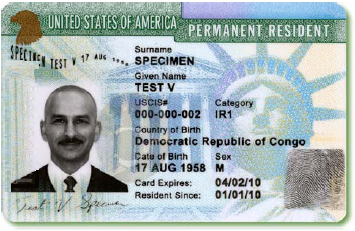What is a Green Card?
The US Permanent Resident Card (official: Form I-551) is an identification document of the USA. Upon application, The US Citizenship and Immigration Services (USCIS) issues the document to persons who are not yet US. Citizens but who have settled in the United States with the intention of immigrating. A green card allows a non- US. Citizen to gain permanent residence in the United States.

Many people from outside the United States want a green card because it would allow them to live and work (lawfully) anywhere in the United States and qualify for Unites States citizenship after three or five years. The card-holders are known as Lawful Permanent Residents (LPR) or in short Permanent Residents. The green card different from other visas in that it allows its holder to reside and work in the United States indefinitely; it is not stuck in the passport like other visas, but creates an independent identification document. There are three stages to the legalization of permanent residency in the United States:
- Immigrant visa
- Permanent Residency with Green Card
- United States citizenship
Facilities of a Green Card.
The US Green Card is one of the most important immigration visas worldwide. The Card holders of this Permanent Resident can benefit from a variety of Facilities:
- Unlimited entry to the United States of America- no need for a US Visa.
- Live without restrictions in any US state.
- You can apply for US citizenship after three or five years.
Green Card facilities for employees
Green Card facilities for Students
- Work visa is not required.
- Free choice of company.
- No problem for changing employer and contracts.
- Less hard work than other non-Americans
Green Card facilities for Students
- Without a student visa you can Studying in the USA.
- Tuition fees can be reduced up to 80%
Green Card facilities for a Pensioner
- Legal and permanent immigration for retirement.
- Entitlement to pension insurance earned in the USA and in your home country, e.g. Germany.
- Entitlement to medical care and other state social benefits.
Note: You must have lived in the USA for at least five years for this entitlement
How can I get a Green Card?
There are three ways to gain a Green Card:
- Based on a job in the USA
- Family reunion
- Winning the DV Lottery
There are different requirements depending on which category is chosen.
In general, a Green Card application must be submitted to the US. Citizenship and Immigration Services (USCIS). Since 2004, this application can be submitted by online. After the immigration authorities have reviewed and approved the application, a consular procedure is usually followed by the US consulate in the home country. The consulate then reviews all documents submitted by the applicant.
How long is a Green Card validity?
Once you received the US Permanent Resident Card , it’s valid for lifetime and can only be revoked under the above conditions. However, the Permanent Resident Green Card must be renewed after ten years, as like an identity card. If you fail to comply with this renewal, you will be liable to pay a fine.
Do I have to immigrate of USA?
U.S. authorities only issue a green card if they are convinced of the applicant’s intent to immigrate. Therefore, a permanent residence permit should not be considered as a possibility to enter the United States for future business or holiday travel. Instead, the focus should be on long-term emigration.
Especially in the early days after receiving a green card, the authorities are aware that not everyone can suddenly leave their previous life and move to the United States. Especially in the first one to three years, traveling between the United States and home is not a problem.
It is important to make sure that after receiving the green card, no one can leave the United States for more than 12 months. Already from 6 months of absence, unpleasant questions about the absence and the real intentions of immigration can arise when entering the country.
Those who cannot enter the United States for more than 12 months must apply in advance for a so-called re-entry permit. With this permit, US Permanent Resident Card holders can stay outside the United States for up to 24 months. This permit is a good for green card holder after receiving this, to be able to prepare for the final emigration. Depending on the age of the card holder, It may cost 575-660 USD to take this permission.
Can I stay in the United States without a Green Card?
An immigration meaning of a permanent residence with free choice of residence and job is only possible with a Green Card or US citizenship.
There are a various visa categories in USA. Student visa is one of them, which you can apply easily. These are always issued for a limited time and are also tied to strict requirements.
How to Apply for a Family-Based Green Card?
The most majority of immigrants apply for a US Permanent Resident Card through a family relationship. For example, almost 70% of the more than one million people who received a green card in 2019 were in a family-based category according to USCIS statistics. The application process for family-based permanent residence is the focus of this below article
US immigration laws provide a various ways to apply for a green card (permanent resident status). The different way come through family relationships, employment, refugee/asylum status, diversity lottery, and several special immigrant classes.

- If You Have Eligibility through a Family Member
Are you related to a US. Citizen or lawful permanent resident? To apply for a green card through a family relationship, you must have one of only a handful of eligible relationships with a US. Citizen or lawful permanent resident. Family-based immigration falls into two categories: immediate relatives and family-preference.
- Immediate Relative Category
Immigration law categorizes the spouse, unmarried children (under age 21) and parents of US. citizens as immediate relatives. That’s it. The immediate relative category is an exclusive group. That’s because an immigrant visa is always available. There is no “wait” for a visa if you are an immediate relative. The paperwork takes some time, but immediate relatives aren’t subject to the long waits associated with other categories. Again, immediate relatives only include:
- Spouse of a US. Citizen
- Unmarried child under the age of 21 of a US. Citizen
- Parent of a US. citizenship who is at least 21 years old
- Family Preference Category
Most other eligible family members fall into the family preference category. Family preference categories often have a longer wait associated with them. That’s because there is a numerical limit of immigrant visas available to family preference immigrants each year.
- Unmarried, adult sons and daughters (age 21 or over) of US. Citizens
- Spouses and unmarried children (under age 21) of permanent residents
- Unmarried adult sons and daughters of permanent residents
- Married sons and daughters (any age) of US. Citizens
- Brothers and sisters of adult US. Citizens
- Other Relationships
The widow of a United States citizen may be eligible for a green card if he or she was married at the time the US. citizen spouse died. Certain family member victims of battery or extreme cruelty by a US. citizen may also be eligible to apply for a US Permanent Resident Card through a VAWA self-petition. These cases can get complicated. Therefore, widow and VAWA self-petitioners should generally work with an immigration attorney to apply.
On the other hand, grandparents, grandchildren, nephews, nieces, uncles, aunts, cousins and in-laws cannot be directly petitioned.
- Receiving Sponsorship from the Family Member
Before you can apply for a green card, an “immigrant visa” must be available. An immigrant visa is a permanent visa that allows a foreign national to permanently live and work in the United States (provided he/she stays within the rules). It’s also known as permanent resident status. USCIS provides every US. permanent resident with a permanent resident card, best known as a green card.
Your family member must begin by requesting an immigrant visa be made available to you. Specifically, the process starts by filing an immigrant petition. Regardless of your family-based category — immediate relative or family preference – the process begins with the US. citizen or permanent resident filing Form I-130, Petition for Alien Relative, with the US. government. Use Form I-130 to establish the existence of a qualifying relationship and to make a request for a visa to be set aside.
As mentioned previously, immediate relatives will always have an available immigrant visa. In contrast, family preference relatives will have a wait that can last a few months to several years. It depends on how many people are also waiting in the same category as well as other factors.
How long does it take to get a green card after marriage?
The current total wait time for a marriage-based Green Card ranges between 09 to 36 months, Based on whether or not you’re married to a US. Citizen or Green Card holder and wherever you presently live (not together with doable delays).
- For US. Citizen.
- In the United States : 14-28 months
- For Abroad : 17-24 months
- For US. Green Card holder.
- In the United States : 22-36 months
- For Abroad : 15-23 months
Apply for a Green Card for US. Citizen
Once the visa petition (Form I-130) is approved and an immigrant visa is immediately available, the family member may submit the application for a green card. Generally, there are two ways this may happen. The family member may apply for a green card outside the United States, and certain persons may apply inside the United States.

- Apply for a Green Card (Outside of the United States)
Most people apply for a green card at a US. embassy or consulate outside the United States. This is formally known as consular processing. The intending immigrant submits the application and all required documentation to the National Visa Center and/or the embassy handling the visa. Then, an embassy official will also conduct a consular interview before granting the immigrant visa.
- Apply for a Green Card (Inside of the United States)
Certain individuals who are physically present in the United States through a lawful entry may be able to use the adjustment of status process to apply for a green card. When adjusting status, the intending immigrant must have an immigrant visa immediately available to them. Generally, this makes adjustment available only to immediate relatives (who always have a visa available). Certain family preference immigrants who have an approved I-130 and a visa is current may also adjust status. But this is less common.
An adjustment of status application typically includes a package of forms and supporting documents to include:
- I-485, Application to Register Permanent Residence or Adjust Status
- I-130, Petition for Alien Relative
- I-130A, Supplemental Information for Spouse Beneficiary (if relative is a spouse)
- I-864, Affidavit of Support
- I-693, Report of Medical Examination and Vaccination Record
- I-765, Application for Employment Authorization (optional)
- I-131, Application for Travel Document (optional)
Green Card Application Package
Filling out forms correctly and assembling a proper package of materials is critical. Based on Lockbox Rejection Data, USCIS rejects almost 10 percent of applications. Once applications are accepted processing, USCIS may also deny the case. In the most recent four quarters, USCIS has an average denial rate of over 18 percent for family-based I-485 applications according to DHS statistics.
Most intending immigrants can apply for a green card on their own, but benefit from some extra help. That’s where Citizen Tests comes in. Our affordable service makes the application process easier with step-by-step guidance. The attorney-designed software provides instant alerts when there’s a problem. In addition to a neatly prepared application that’s ready to sign, our customers get detailed filing instructions based on their answers. The customized filing instructions provide directions for supporting documents, how to assemble the package and where to mail it. Watch a video explainer or get started for free.
Green Card Processing Time
Several factors affect the green card time line. For starters, the eligibility category (immediate relative or family preference) has a significant affect on the wait. As explained, a green card is always available to immediate relatives. However, family preference categories can wait a few months up to 20 years in some cases. For applicants that are able to adjust status within the United States, the I-485 time line can generally last from 8 to 14 months. However, it can take longer for certain cases.
About Citizens tests
Citizenstests provides simple, affordable, step-by-step guidance through USCIS immigration applications. Individuals, attorneys and non-profits use the service on desktop or mobile device to prepare immigration forms accurately, avoiding costly delays. Citizenstests allows users to try the service for free and provides a 100% money-back guarantee that USCIS will approve the application or petition. We provide support for the Green Card Replacement Application (Form I-90), US Citizenship Application (Form N-400), and several other USCIS forms.
Want to sign up for our weekly newsletter covering all things immigration?
You may also know this

